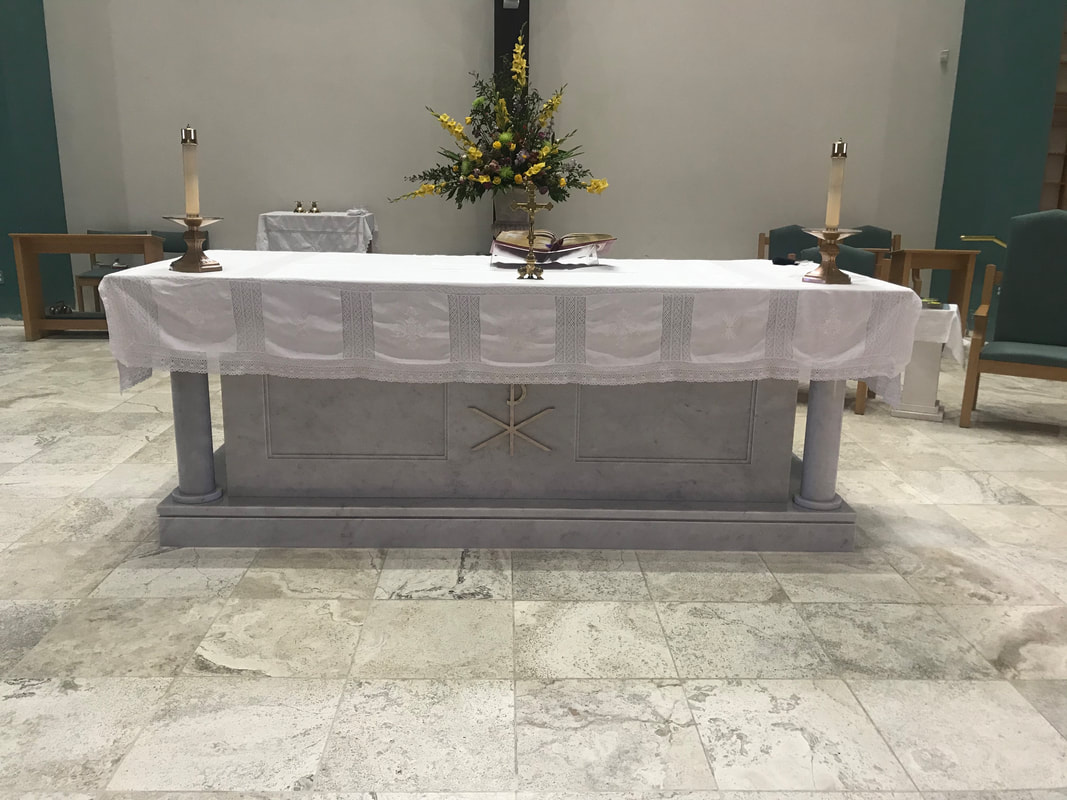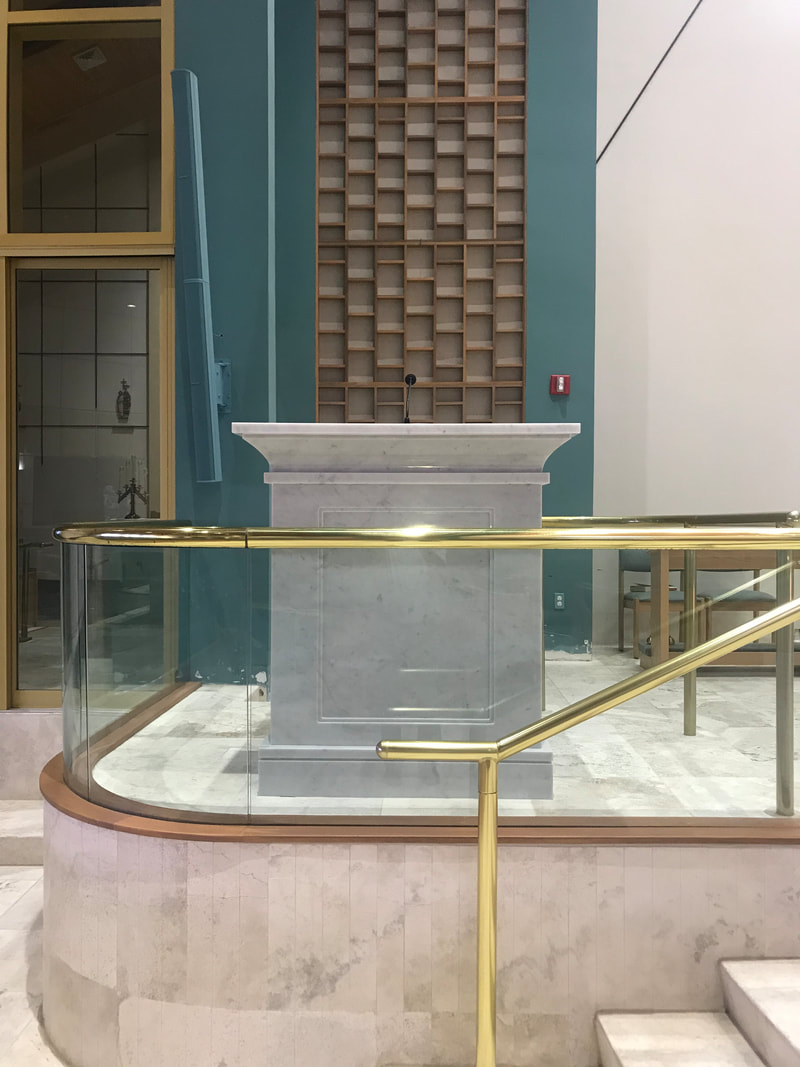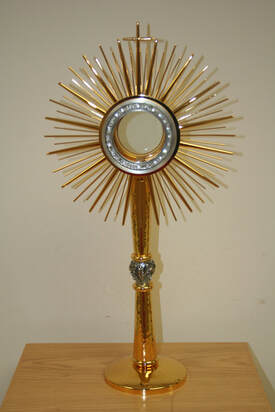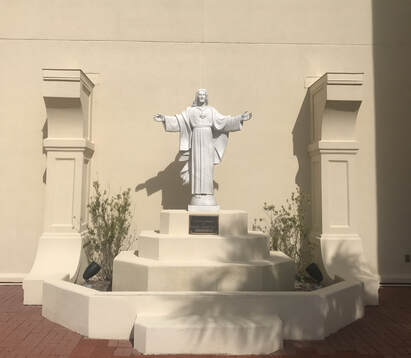Decorative Elements of Church
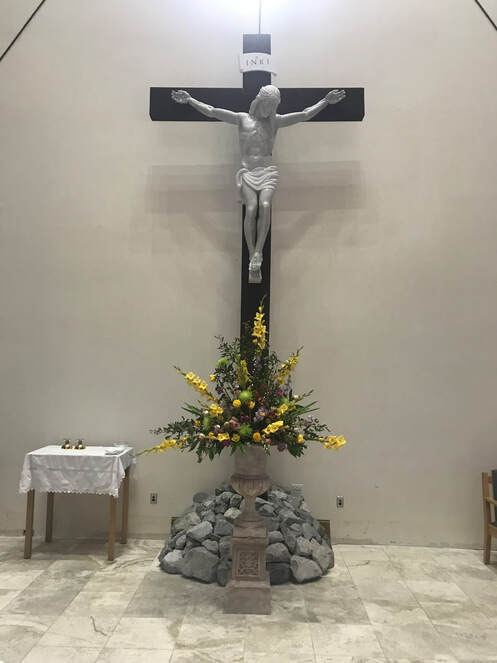
The Crucifix (in the Sanctuary)
The wooden cross is solid hand-hewn cypress and the Corpus was expertly carved of first-grade Chiaro marble in Italy. The Corpus weighs just over one ton and is slightly larger than life-size. The marble for this masterpiece was chosen for its finished polished beauty. Some twenty slabs of marble were considered before Geno Barsanti (the master carver in Italy) chose the one from which this Corpus emerged. Geno says that you “only have to remove the marble which doesn’t belong”. It took some twenty-two weeks for the body of the Corpus to be completed and an additional three weeks for each arm. Both arms were attached after the Cross and Corpus were in place.
The Corpus stands 7’2” and his arms reach over 6’. The arms are attached with white cement and epoxy (the same epoxy used to install windshields in helicopters). Some of the unique features of the carving are the drape of the loincloth and the hair of Jesus, which were left unpolished, while the body was polished. The side cut (the spearing of Jesus) was also left unpolished. Another unique feature is the mounting of the Corpus to the Cross. This was achieved with one single bronze pin, which was custom made for this Corpus. Only 4.5” in length, this pin is the only thing holding the corpus to the cross. The pin weighs 11 lbs. and is mounted through the cross and in the lower middle back of the Corpus.
The Cross was just as hard to create. It stands just over 20’ and the cross bar is 7.5’. It consists of hand-hewed cypress from Coffeeville, Alabama, cut some five years earlier and stored in a barn to dry. We had searched all of the United States and Canada for hardwood which could hold the Corpus, and finally we found it in our own back yard. The timber used was chosen for its length, width, straightness, and beauty. The piece was milled down to the correct size and cut into two pieces, one 22’ x 1’ x 8” and the other 8’ x 1’x 8”. It was finished on site by David Lowery, who also erected the Cross and Corpus.
This is the largest stone carved Crucifix in Alabama, and probably the largest in the South. The finished sculpture stands 21.5’ high and 7.5’ wide and weighs over 1.4 tons. It took sixteen men, two cranes and some six hours to erect.
This ‘Holy Reminder’ is just that – a holy reminder and a tribute to the crucified Lord who rises from the dead and lives in the Holy Eucharist.
The wooden cross is solid hand-hewn cypress and the Corpus was expertly carved of first-grade Chiaro marble in Italy. The Corpus weighs just over one ton and is slightly larger than life-size. The marble for this masterpiece was chosen for its finished polished beauty. Some twenty slabs of marble were considered before Geno Barsanti (the master carver in Italy) chose the one from which this Corpus emerged. Geno says that you “only have to remove the marble which doesn’t belong”. It took some twenty-two weeks for the body of the Corpus to be completed and an additional three weeks for each arm. Both arms were attached after the Cross and Corpus were in place.
The Corpus stands 7’2” and his arms reach over 6’. The arms are attached with white cement and epoxy (the same epoxy used to install windshields in helicopters). Some of the unique features of the carving are the drape of the loincloth and the hair of Jesus, which were left unpolished, while the body was polished. The side cut (the spearing of Jesus) was also left unpolished. Another unique feature is the mounting of the Corpus to the Cross. This was achieved with one single bronze pin, which was custom made for this Corpus. Only 4.5” in length, this pin is the only thing holding the corpus to the cross. The pin weighs 11 lbs. and is mounted through the cross and in the lower middle back of the Corpus.
The Cross was just as hard to create. It stands just over 20’ and the cross bar is 7.5’. It consists of hand-hewed cypress from Coffeeville, Alabama, cut some five years earlier and stored in a barn to dry. We had searched all of the United States and Canada for hardwood which could hold the Corpus, and finally we found it in our own back yard. The timber used was chosen for its length, width, straightness, and beauty. The piece was milled down to the correct size and cut into two pieces, one 22’ x 1’ x 8” and the other 8’ x 1’x 8”. It was finished on site by David Lowery, who also erected the Cross and Corpus.
This is the largest stone carved Crucifix in Alabama, and probably the largest in the South. The finished sculpture stands 21.5’ high and 7.5’ wide and weighs over 1.4 tons. It took sixteen men, two cranes and some six hours to erect.
This ‘Holy Reminder’ is just that – a holy reminder and a tribute to the crucified Lord who rises from the dead and lives in the Holy Eucharist.
|
The Altar (Sanctuary)
The Altar is white Carrara marble and weighs upward of 1000 lbs. The Altar was assembled on site by the contractor. It measures 4’ x 10’ and was consecrated by Archbishop Oscar H. Lipscomb on December 17, 2000. The Altar was sprinkled with Holy Water and consecrated with Chrism Oil and blessed by the Archbishop before the first Mass was offered. |
|
The Ambo
The Ambo in the Sanctuary is also white Carrara marble and was received in 15 pieces, then assembled on site. The Readings and Gospel are read from the Ambo. The word ‘ambo’ is taken from the Greek and Latin and means Ambulatory; the raised stand was used for reading the Gospel and Epistles in early Christian basilicas. |
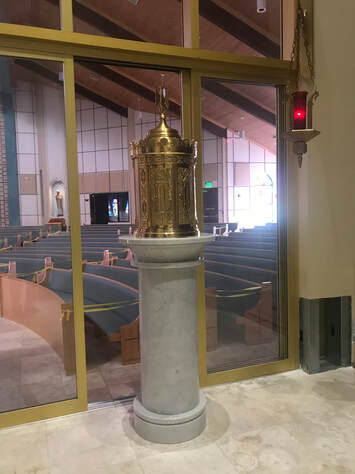
The Tabernacles
The Tabernacle is the resting place for the Blessed Sacrament (the body and blood of Jesus) when Mass is not being celebrated.
Our church has two Tabernacles, one in the main Sanctuary and the other in the Chapel. They are identical, and were made in Chicago by Excelsis, solid cast bronze with 24kt gold overlay hammered and plated to the bronze.
A Sanctuary Lamp is in place next to each of the Tabernacles. It is always lit when the Blessed Sacrament is present in the Tabernacle. The candle within the lamps is changed every seven days.
The Tabernacle is the resting place for the Blessed Sacrament (the body and blood of Jesus) when Mass is not being celebrated.
Our church has two Tabernacles, one in the main Sanctuary and the other in the Chapel. They are identical, and were made in Chicago by Excelsis, solid cast bronze with 24kt gold overlay hammered and plated to the bronze.
A Sanctuary Lamp is in place next to each of the Tabernacles. It is always lit when the Blessed Sacrament is present in the Tabernacle. The candle within the lamps is changed every seven days.
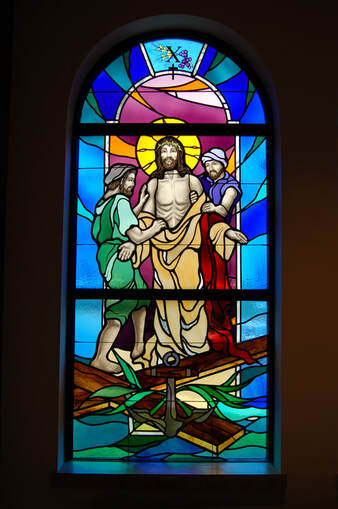
Stained Glass Windows/Stations of the Cross
The stained glass windows were designed by renowned American stained glass artist Richard A. Buswell and crafted in Virginia of mouth-blown antique glass by the Lynchburg Stained Glass Company.
The dramatic Stations of the Cross windows, the two exquisite Rose windows (the Resurrection of Jesus and the Nativity), the beautiful Clerestory windows, and the radiant Baptistery window are wonderful examples of Buswell’s artistic concern for color, texture, movement and imagery. He has masterfully used symbolism in each of his windows, from the wheat and grapes motif (representing Christ’s body and blood) to the palm leaf and olive branch which symbolize martyrdom and reconciliation. The anchor in the center of the leaves represents Christ as (in the artist’s own words) “… the anchor in the storm of our daily lives… very appropriate in regards to the geographic location of this new church”.
The stained glass windows were designed by renowned American stained glass artist Richard A. Buswell and crafted in Virginia of mouth-blown antique glass by the Lynchburg Stained Glass Company.
The dramatic Stations of the Cross windows, the two exquisite Rose windows (the Resurrection of Jesus and the Nativity), the beautiful Clerestory windows, and the radiant Baptistery window are wonderful examples of Buswell’s artistic concern for color, texture, movement and imagery. He has masterfully used symbolism in each of his windows, from the wheat and grapes motif (representing Christ’s body and blood) to the palm leaf and olive branch which symbolize martyrdom and reconciliation. The anchor in the center of the leaves represents Christ as (in the artist’s own words) “… the anchor in the storm of our daily lives… very appropriate in regards to the geographic location of this new church”.
|
The Monstrance
The Monstrance is gold-plated and holds the Body of Christ and is used at Benediction. When in use, the Luna (the clamp which holds the consecrated Body of Christ) is placed inside the Monstrance and the glass door is closed. The Priest, Deacon or Lay Minister will have a Humeral Veil placed around their shoulders during Benediction so as not to touch the Monstrance for elevation. This exposure of the Blessed Sacrament is an expression of adoration and contemplation of what Jesus did for us. Once Benediction nears completion, the celebrant will make the sign of the cross with the Monstrance for the blessing from Christ to descend to the congregation. The Monstrance is placed back on the altar, the class door is opened and the Luna is removed and returned to the Tabernacle. |
The Blessed Mother and Working St. Joseph
The statues of the Blessed mother and Working St. Joseph are of a vinyl-wood combination product and hand painted. Each stands 5’8” tall and is placed in a niche in the north wall of the Sanctuary.
A note about our Catholic faith: we only adore and pray to God, Christ our Lord, and the Holy Spirit. However, we do ask the Saints (those who have been declared Saints by the church, as well as those who have gone before us and are now in the heavenly presence of God) to intercede to God on our behalf. As most would tell you, their mother had the greatest influence in their life; therefore we ask our Blessed Mother Mary to ask her Son, our brother Jesus, for help in our difficulties and to grant various requests¸ all while knowing that God (the Father, his Son Jesus, and the Holy Spirit) is the only entity that can grant them.
The statues of the Blessed mother and Working St. Joseph are of a vinyl-wood combination product and hand painted. Each stands 5’8” tall and is placed in a niche in the north wall of the Sanctuary.
A note about our Catholic faith: we only adore and pray to God, Christ our Lord, and the Holy Spirit. However, we do ask the Saints (those who have been declared Saints by the church, as well as those who have gone before us and are now in the heavenly presence of God) to intercede to God on our behalf. As most would tell you, their mother had the greatest influence in their life; therefore we ask our Blessed Mother Mary to ask her Son, our brother Jesus, for help in our difficulties and to grant various requests¸ all while knowing that God (the Father, his Son Jesus, and the Holy Spirit) is the only entity that can grant them.
The Crucifix (in the Chapel)
The 40” Crucifix in the Chapel is by Fontanini and is made of fiberglass. The original was commissioned by Pope Pius X for one of the chambers in the Pope’s private retreat in Rome.
A note of interest – most crucifixes are measured by the Corpus only, not the Cross; so if you have a 2’ Crucifix, the Corpus measures 2’ and the Cross would measure 3’ to 3’5”.
The 40” Crucifix in the Chapel is by Fontanini and is made of fiberglass. The original was commissioned by Pope Pius X for one of the chambers in the Pope’s private retreat in Rome.
A note of interest – most crucifixes are measured by the Corpus only, not the Cross; so if you have a 2’ Crucifix, the Corpus measures 2’ and the Cross would measure 3’ to 3’5”.
The Altar (in the Chapel)
The Altar was donated by Our Lady of the Gulf Church in Gulf Shores, Alabama and was Father Lambert’s first Altar. It was used in the Parish Hall at St. Thomas by the Sea until the Church was completed in 2000. The marble is believed to be from a vein found in the northeast United States. The contractor was able to disassemble the Altar and rebuild it in the new Church.
The Altar was donated by Our Lady of the Gulf Church in Gulf Shores, Alabama and was Father Lambert’s first Altar. It was used in the Parish Hall at St. Thomas by the Sea until the Church was completed in 2000. The marble is believed to be from a vein found in the northeast United States. The contractor was able to disassemble the Altar and rebuild it in the new Church.
The Stations of the Cross (in the Chapel)
The Stations of the Cross in the Chapel are fiberglass and wood, and were also made in Italy. There are 14 Stations of the Cross, starting from the condemnation of Jesus to his death and burial.
The Stations of the Cross in the Chapel are fiberglass and wood, and were also made in Italy. There are 14 Stations of the Cross, starting from the condemnation of Jesus to his death and burial.
The St. Thomas statue (in the narthex)
This statue of St. Thomas the apostle and Jesus was commissioned by a parishioner, and was illustrated by Eugenia Foster, a well-respected local artist. The drawings were sent to Italy, and a set of working drawings were returned for approval.
Once approved, the creation of the sculpture took 20 weeks to complete. It was placed outside in front of the Parish Hall (now enclosed in the Church narthex). The sculpture, carved in white Carrara marble, stands 5’5” in height and weighs 1,500 lbs.
This statue of St. Thomas the apostle and Jesus was commissioned by a parishioner, and was illustrated by Eugenia Foster, a well-respected local artist. The drawings were sent to Italy, and a set of working drawings were returned for approval.
Once approved, the creation of the sculpture took 20 weeks to complete. It was placed outside in front of the Parish Hall (now enclosed in the Church narthex). The sculpture, carved in white Carrara marble, stands 5’5” in height and weighs 1,500 lbs.
|
The Sacred Heart of Jesus (located in front of the Church)
This sculpture stands 5’6” tall and weighs 600 lbs. This Christ is presented as wind-blown and in movement, and was inspired by the description of Christ walking on the water - so fitting for its placement in front of this church situated across from the Gulf of Mexico. The marble is white Carrara from the same vein as the Pieta by Michelangelo, which today can be found in St. Peter’s Basilica in Rome. His arms are outstretched to welcome all to the Church. |
The St. Michael Prayer Garden
The Prayer Garden was dedicated by Archbishop Thomas Rodi on May 17, 2023. The focal point is a near life-size statue of St. Michael the Archangel, in hand-carved marble which was produced in Mexico. Its design is based on a painting entitled The Archangel Michael Defeating Satan by Guido Reni (painted in 1636 – the painting itself is in the Our Lady of the Conception of the Capuchins chapel in Rome, Italy). The statue weighs about 1500 lbs., and St. Michael stands 72” to the top of his wing.
The garden includes a fountain and flowers; a number of benches are available for those seeking quiet contemplation and meditation.
St. Michael's presence can be traced back to early Jewish writings, particularly in texts from the 3rd and 2nd centuries BC. In these ancient texts, he is depicted as the chief among angels and archangels, responsible for guarding and caring for Israel. He appears in the Book of Enoch as one of the seven archangels, alongside Uriel, Raguel, Raphael, Sariel, Gabriel, and Remiel. These archangels are described as standing before the glory of the Lord.
St. Michael's role as a defender of faith and a warrior against evil is most vividly portrayed in the New Testament, particularly in the Book of Revelation (Revelation 12:7-12). Here, he engages in a cosmic battle against Satan, casting the adversary out of heaven and preventing him from accusing humanity before God. St. Michael's triumphant role in this battle marks a significant shift from the Old Testament to the New Testament.
In the Epistle of Jude, St. Michael is cited as an example of righteous judgment and opposition to evil. He is contrasted with heretics, as he did not hesitate to rebuke Satan over the body of Moses, saying, "The Lord punish you!" This passage underscores St. Michael's unwavering commitment to God's divine justice.
Catholics frequently turn to St. Michael for protection and guidance. The "Prayer to Saint Michael" specifically implores his defense against the forces of darkness.
Prayer to St. Michael
St. Michael the Archangel, defend us in battle, be our protection against the wickedness and snares of the devil. May God rebuke him we humbly pray; and do thou, O Prince of the Heavenly host, by the power of God, cast into hell Satan and all the evil spirits who prowl about the world seeking the ruin of souls.
Amen.
The Prayer Garden was dedicated by Archbishop Thomas Rodi on May 17, 2023. The focal point is a near life-size statue of St. Michael the Archangel, in hand-carved marble which was produced in Mexico. Its design is based on a painting entitled The Archangel Michael Defeating Satan by Guido Reni (painted in 1636 – the painting itself is in the Our Lady of the Conception of the Capuchins chapel in Rome, Italy). The statue weighs about 1500 lbs., and St. Michael stands 72” to the top of his wing.
The garden includes a fountain and flowers; a number of benches are available for those seeking quiet contemplation and meditation.
St. Michael's presence can be traced back to early Jewish writings, particularly in texts from the 3rd and 2nd centuries BC. In these ancient texts, he is depicted as the chief among angels and archangels, responsible for guarding and caring for Israel. He appears in the Book of Enoch as one of the seven archangels, alongside Uriel, Raguel, Raphael, Sariel, Gabriel, and Remiel. These archangels are described as standing before the glory of the Lord.
St. Michael's role as a defender of faith and a warrior against evil is most vividly portrayed in the New Testament, particularly in the Book of Revelation (Revelation 12:7-12). Here, he engages in a cosmic battle against Satan, casting the adversary out of heaven and preventing him from accusing humanity before God. St. Michael's triumphant role in this battle marks a significant shift from the Old Testament to the New Testament.
In the Epistle of Jude, St. Michael is cited as an example of righteous judgment and opposition to evil. He is contrasted with heretics, as he did not hesitate to rebuke Satan over the body of Moses, saying, "The Lord punish you!" This passage underscores St. Michael's unwavering commitment to God's divine justice.
Catholics frequently turn to St. Michael for protection and guidance. The "Prayer to Saint Michael" specifically implores his defense against the forces of darkness.
Prayer to St. Michael
St. Michael the Archangel, defend us in battle, be our protection against the wickedness and snares of the devil. May God rebuke him we humbly pray; and do thou, O Prince of the Heavenly host, by the power of God, cast into hell Satan and all the evil spirits who prowl about the world seeking the ruin of souls.
Amen.
